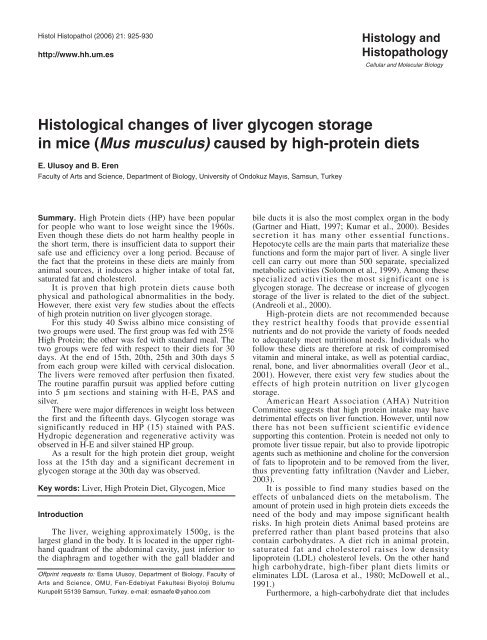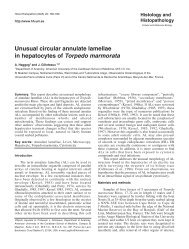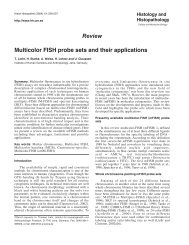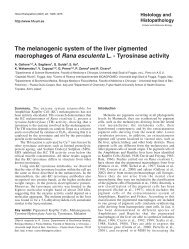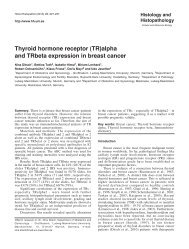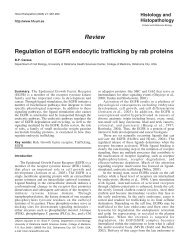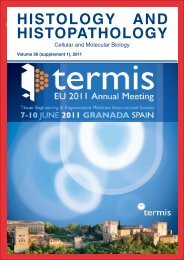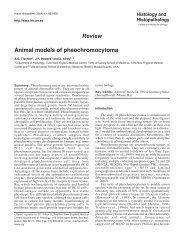Full text-PDF - Histology and Histopathology
Full text-PDF - Histology and Histopathology
Full text-PDF - Histology and Histopathology
You also want an ePaper? Increase the reach of your titles
YUMPU automatically turns print PDFs into web optimized ePapers that Google loves.
Histol Histopathol (2006) 21: 925-930<br />
http://www.hh.um.es<br />
<strong>Histology</strong> <strong>and</strong><br />
<strong>Histopathology</strong><br />
Cellular <strong>and</strong> Molecular Biology<br />
Histological changes of liver glycogen storage<br />
in mice (Mus musculus) caused by high-protein diets<br />
E. Ulusoy <strong>and</strong> B. Eren<br />
Faculty of Arts <strong>and</strong> Science, Department of Biology, University of Ondokuz Mayıs, Samsun, Turkey<br />
Summary. High Protein diets (HP) have been popular<br />
for people who want to lose weight since the 1960s.<br />
Even though these diets do not harm healthy people in<br />
the short term, there is insufficient data to support their<br />
safe use <strong>and</strong> efficiency over a long period. Because of<br />
the fact that the proteins in these diets are mainly from<br />
animal sources, it induces a higher intake of total fat,<br />
saturated fat <strong>and</strong> cholesterol.<br />
It is proven that high protein diets cause both<br />
physical <strong>and</strong> pathological abnormalities in the body.<br />
However, there exist very few studies about the effects<br />
of high protein nutrition on liver glycogen storage.<br />
For this study 40 Swiss albino mice consisting of<br />
two groups were used. The first group was fed with 25%<br />
High Protein; the other was fed with st<strong>and</strong>ard meal. The<br />
two groups were fed with respect to their diets for 30<br />
days. At the end of 15th, 20th, 25th <strong>and</strong> 30th days 5<br />
from each group were killed with cervical dislocation.<br />
The livers were removed after perfusion then fixated.<br />
The routine paraffin pursuit was applied before cutting<br />
into 5 µm sections <strong>and</strong> staining with H-E, PAS <strong>and</strong><br />
silver.<br />
There were major differences in weight loss between<br />
the first <strong>and</strong> the fifteenth days. Glycogen storage was<br />
significantly reduced in HP (15) stained with PAS.<br />
Hydropic degeneration <strong>and</strong> regenerative activity was<br />
observed in H-E <strong>and</strong> silver stained HP group.<br />
As a result for the high protein diet group, weight<br />
loss at the 15th day <strong>and</strong> a significant decrement in<br />
glycogen storage at the 30th day was observed.<br />
Key words: Liver, High Protein Diet, Glycogen, Mice<br />
Introduction<br />
The liver, weighing approximately 1500g, is the<br />
largest gl<strong>and</strong> in the body. It is located in the upper righth<strong>and</strong><br />
quadrant of the abdominal cavity, just inferior to<br />
the diaphragm <strong>and</strong> together with the gall bladder <strong>and</strong><br />
Offprint requests to: Esma Ulusoy, Department of Biology, Faculty of<br />
Arts <strong>and</strong> Science, OMU, Fen-Edebiyat Fakultesi Biyoloji Bolumu<br />
Kurupelit 55139 Samsun, Turkey. e-mail: esmaefe@yahoo.com<br />
bile ducts it is also the most complex organ in the body<br />
(Gartner <strong>and</strong> Hiatt, 1997; Kumar et al., 2000). Besides<br />
secretion it has many other essential functions.<br />
Hepotocyte cells are the main parts that materialize these<br />
functions <strong>and</strong> form the major part of liver. A single liver<br />
cell can carry out more than 500 separate, specialized<br />
metabolic activities (Solomon et al., 1999). Among these<br />
specialized activities the most significant one is<br />
glycogen storage. The decrease or increase of glycogen<br />
storage of the liver is related to the diet of the subject.<br />
(Andreoli et al., 2000).<br />
High-protein diets are not recommended because<br />
they restrict healthy foods that provide essential<br />
nutrients <strong>and</strong> do not provide the variety of foods needed<br />
to adequately meet nutritional needs. Individuals who<br />
follow these diets are therefore at risk of compromised<br />
vitamin <strong>and</strong> mineral intake, as well as potential cardiac,<br />
renal, bone, <strong>and</strong> liver abnormalities overall (Jeor et al.,<br />
2001). However, there exist very few studies about the<br />
effects of high protein nutrition on liver glycogen<br />
storage.<br />
American Heart Association (AHA) Nutrition<br />
Committee suggests that high protein intake may have<br />
detrimental effects on liver function. However, until now<br />
there has not been sufficient scientific evidence<br />
supporting this contention. Protein is needed not only to<br />
promote liver tissue repair, but also to provide lipotropic<br />
agents such as methionine <strong>and</strong> choline for the conversion<br />
of fats to lipoprotein <strong>and</strong> to be removed from the liver,<br />
thus preventing fatty infiltration (Navder <strong>and</strong> Lieber,<br />
2003).<br />
It is possible to find many studies based on the<br />
effects of unbalanced diets on the metabolism. The<br />
amount of protein used in high protein diets exceeds the<br />
need of the body <strong>and</strong> may impose significant health<br />
risks. In high protein diets Animal based proteins are<br />
preferred rather than plant based proteins that also<br />
contain carbohydrates. A diet rich in animal protein,<br />
saturated fat <strong>and</strong> cholesterol raises low density<br />
lipoprotein (LDL) cholesterol levels. On the other h<strong>and</strong><br />
high carbohydrate, high-fiber plant diets limits or<br />
eliminates LDL (Larosa et al., 1980; McDowell et al.,<br />
1991.)<br />
Furthermore, a high-carbohydrate diet that includes
926<br />
Effects of high protein diet on liver<br />
fruit, vegetables, non-fat dairy products, <strong>and</strong> whole<br />
grains has been shown to lower blood pressure (Appel et<br />
al., 1997). In other words limitation of these foods may<br />
raise blood pressure <strong>and</strong> may cause reduction in<br />
potassium, calcium, <strong>and</strong> magnesium coupled with an<br />
increase in sodium intake. High protein foods such as<br />
meat, poultry, seafood, eggs, seeds, <strong>and</strong> nuts are high in<br />
purines. Purines are broken down into uric acid, so<br />
excess consumption of these foods increases uric acid<br />
levels (Franzese, 2000). A surplus of protein in the<br />
system also increases urinary calcium loss, which may<br />
increase the risk of osteoporosis (Abelow et al., 1992;<br />
Feskanich et al., 1996; Barzel <strong>and</strong> Massey, 1998). High<br />
Protein Diets increase nitrogen in the tissues; as a result<br />
it stimulates amino acid degradation, followed by a large<br />
rise in urea production in liver (Morens et al., 2000). As<br />
a result, increased glomerular filtration rates (Hammond<br />
<strong>and</strong> Janes, 1998), renal <strong>and</strong> glomerular hypertrophy<br />
(Schrijvers et al., 2002), <strong>and</strong> decreased urine pH.<br />
(Schuette, 1980; Fellstrom et al., 1983) were observed.<br />
Increased uric acid levels may cause gout in sensitive<br />
individuals (Abelow et al., 1992; Franzese, 2000). In<br />
addition a decrease in calcium by urinating may increase<br />
the risk of kidney stones (Wiederkehr <strong>and</strong> Krapf, 2001;<br />
Reddy et al., 2002) also some types of cancer (Willet et<br />
al., 1990; Giovannucci et al., 1994).<br />
Moreover there has been research on mental<br />
performance of individuals <strong>and</strong> it was observed that HP<br />
diets lead to lower memory performance <strong>and</strong> lower level<br />
of concentration. These results suggest that carbohydrate<br />
<strong>and</strong> protein based diets have different effects on mental<br />
health. For example, Smith et al. (1988) compared the<br />
performance of three groups which have different diets<br />
(high-starch, high-sugar, or high-protein) on<br />
concentration <strong>and</strong> reported that the carbohydrate diet<br />
group has better performance than the others (Dye et al.,<br />
2000).<br />
Also Jorda et al. (1988) reported that the liver<br />
responds to the high-protein diet by a proliferation of<br />
normally functioning mitochondria.<br />
Apart from this histologic research there has not<br />
been another on the effects on liver glycogen storage on<br />
the metabolism those who are on high protein diets. For<br />
this reason the aim of this research is to identity<br />
histologicly the change dependence at term in the liver<br />
glycogen storage of the mice having HP diets.<br />
Materials <strong>and</strong> methods<br />
Forty male Swiss albino laboratory mice (Mus<br />
musculus), 60-90 day-old, average initial body weights<br />
24-42 g, were used in this study. The animals were<br />
housed in individual wireless steel cages under<br />
st<strong>and</strong>ardized conditions of temperature <strong>and</strong> light.<br />
The animals were divided into two groups. The first<br />
group was the one which was fed with HP diets (casein)<br />
the other was the control (C) group that was fed with<br />
st<strong>and</strong>ard diet. All the mice were given 12±2 g diet per<br />
day in separated cages. While the control group was<br />
given a st<strong>and</strong>ard diet the other was fed with 25% HP diet<br />
(Reeves et al., 1993). HP diet used on mice was prepared<br />
by powder (Table 1). This powder has made by fat-free<br />
casein <strong>and</strong> gluten-free. As 2.5 g powder was equal to 2.2<br />
g protein; this 25% HP was prepared, diluting distilated<br />
water 6.3±1 + 2.5 g powder.<br />
The animals were free access to water <strong>and</strong> were fed<br />
with their own diet for 30 days. At the end of 15th, 20th,<br />
25th <strong>and</strong> 30th days, 5 from each group were killed by<br />
cervical dislocation after being weighed. The livers were<br />
perfused with saline solution (0,9%) injected through<br />
main hepatic artery <strong>and</strong> then removed. Later the liver<br />
tissues were fixated with 80% ethanol for 12 hours. The<br />
fixated liver tissues were embedded in paraffin <strong>and</strong> cut<br />
into 5 µm sections <strong>and</strong> then stained with H-E, PAS <strong>and</strong><br />
silver (Bancroft <strong>and</strong> Stevens, 1996).<br />
In our study, we used analytically pure substances<br />
provided by Sigma-London Company, st<strong>and</strong>ard meal<br />
was provided by Samsun Yem Company <strong>and</strong> the protein<br />
which was used to prepare the HP diet was provided by<br />
Nutricia Cuijk-Holl<strong>and</strong> Company.<br />
Data gathered was examined in five different periods<br />
for normal distribution. For data a normal distribution<br />
analysis of variance (ANOVA) was used. Statistics were<br />
performed by the statistical package SPSS for Windows.<br />
The limit of significance was set at p
Effects of high protein diet on liver<br />
927<br />
to 30th. On the 30th day (Fig. 7) the glycogen storage<br />
was almost finished. A small amount of dilatation in<br />
sinusoids was detected (Fig. 8).<br />
In H-E staining no difference on radial symmetry in<br />
hepatocyte of HP liver tissues was detected <strong>and</strong> portal<br />
triads were observed as normal <strong>and</strong> also hydropic<br />
degeneration was on a small-scale (Fig. 9).<br />
It was observed that regenerative activity was<br />
mainly in 25th <strong>and</strong> 30th day in HP group stained with<br />
silver method (Fig. 10).<br />
Discussion<br />
The explanation of the first weeks of HP diet group’s<br />
loss of weight (12.5%) <strong>and</strong> the stability afterwards is as<br />
follows: It is known that mobilization of protein stores<br />
supply amino acids for liver gluconeogenesis in many<br />
Fig. 1. Weight curves of mice, fed high protein (HP) <strong>and</strong> normal(C)<br />
diets. Body weights of 30 day old mice.<br />
Fig. 3. Light micrograph of the histological view of livers in C (15).<br />
Observe densely glycogen deposits in the hepotocyte cytoplasm (a)<br />
around the central vein (cv). These accumulations are seen as pink<br />
areas of PAS-positive material throughout the section. PAS, x 200<br />
Fig. 2. A. The macroscopic view of the control group livers of the mice.<br />
B. Showing a remarkable macroscopic view of the mice which were fed<br />
with High-protein diet were darker).<br />
Fig. 4. Light micrograph of the histological view of livers in C (15). The<br />
glycogen deposits were removed leaving only the plasma membrane<br />
<strong>and</strong> certain carbohydrate (a) staining pink. PAS stain after diastase<br />
digestion, x 200
928<br />
Effects of high protein diet on liver<br />
vertebrates in the absence of food intake (Kraus-<br />
Friedmann, 1984). The usage of this metabolic pathway<br />
increases in HP diets <strong>and</strong> remains constant on lack of<br />
long-term food intake (Silva <strong>and</strong> Migliorini, 1990;<br />
Sartori et al., 1995). HP diets promise that as long as<br />
carbohydrates are restricted, some weight will be lost;<br />
despite no limitation in food consumption. High protein<br />
<strong>and</strong> high lipid diets start metabolic ketosis, <strong>and</strong> these<br />
diets are charming because they lead to rapid loss of<br />
weight. The weight loss in the short term was reported to<br />
be a result of the diuretic effect that was caused by low<br />
carbohydrate intake <strong>and</strong> it was proved that this low<br />
calorie intake might cause lack of appetite as long as the<br />
same diet was kept up (Jama, 1973; Denke, 2001). Some<br />
high protein, very low carbohydrate, weight-loss diets<br />
induce ketosis <strong>and</strong> when carbohydrate intake or<br />
utilization is insufficient to provide glucose to the cells,<br />
ketone bodies that are formed from fatty acids are used<br />
as an energy source. An increase in ketones can disturb<br />
the body’s acid-base balance, causing metabolic acidosis<br />
Fig. 5. Light micrograph of the histological view of livers in HP (20).<br />
Observe the minimal quantities of glycogen deposits in the hepotocyte<br />
cytoplasm (a) around the central vein (cv). They correspond to the pinkpurple<br />
stained areas. The nucleus of hepotocyte (b) <strong>and</strong> sinusoids (c).<br />
PAS, x 200<br />
Fig. 6. Light micrograph of the histological view of livers in HP (20).<br />
Observe the similarity of the image as in figure 5. The glycogen deposits<br />
were removed <strong>and</strong> only minimal quantities of certain carbohydrate were<br />
left (a). PAS stain after diastase digestion, x 200<br />
Fig. 7. Light micrograph of the histological view of livers in HP group<br />
(30). Glycogen deposits decreased to a minumum (a), showing a<br />
remarkable increase of regenerative activity of hepotoctes (b),<br />
erythrocytes (c), brownish deposits within hepotocytes (d) <strong>and</strong> cenral<br />
vein (cv). PAS, x 600<br />
Fig. 8. Light micrograph of the histological view of livers in HP group<br />
(15). Observe the little amount of glycogen deposits (a) around the<br />
central vein (cv). Binucleate liver cells (b), little width sinusoids (c). PAS,<br />
x 400
Effects of high protein diet on liver<br />
929<br />
Fig. 9. Light micrograph of the histological view of livers in HP group<br />
(15). Also, a portal canal appears with normal aspect. Portal vein (pv),<br />
hepatic artery (ha), bile duct (a) <strong>and</strong> erythrocytes. Hepotocytes (c)<br />
appear as interconnecting cords. H-E x 150<br />
Fig. 10. Light micrograph of the histological view of livers in HP group<br />
(25). Showing a remarkable increase in regenerative activity (a) around<br />
the central vein (cv) , reticular fibers (b), the differences between nuclei<br />
size (c) <strong>and</strong> The Kupffer cells (d). Silver, X 600.<br />
(Wiederkehr <strong>and</strong> Krapf, 2001). The weight loss in the<br />
HP group has the same characteristics as the weight<br />
losses in the studies mentioned above.<br />
It was observed that the livers of the animals which<br />
were fed with HP were darker than the control group’s.<br />
Kumar (2000) has declared that the reasons for visible<br />
protein deposition are intake of protein to cells or excess<br />
synthesis of protein in cells. According to the results of<br />
this study, it can be declared that the colour change was<br />
due to excessive protein storage in hepatocytes.<br />
Histological examination proved that the glycogen<br />
storage in HP group kept decreasing through the 15th till<br />
the 30th day.<br />
Insulin resistance can lead to a reduction in glycogen<br />
synthesis (Radziuk, 1982) whereas elevation in the<br />
catecholamine levels can contribute to increased<br />
glycogen degradation (Kuwajima et al., 1986; Fedatto-<br />
Junior et al., 2002). In addition to this result explaining<br />
the glycogen decrease; gluconeogenesis way is known to<br />
require much more energy (Nelson <strong>and</strong> Cox, 2000).<br />
According to Kumar (2000) an unbalanced diet is<br />
one of the main causes of cell damage. He reported that<br />
after rapid consumption of glycogen, glycolysis<br />
increased <strong>and</strong> the hydrolysis of phosphate esters allows<br />
lactic acid <strong>and</strong> inorganic phosphate to accumulate. He<br />
also added that this condition caused a decrease of pH in<br />
cells. Reports support dilatations in sinusoids <strong>and</strong><br />
hydropic degenerations found in this research.<br />
In our studies a significant regenerative activity in<br />
HP diet groups was observed, compared to control<br />
groups. Research done by Jorda et al. (1988) supports<br />
our findings. According to the research, rodents fed very<br />
high protein intakes have been found to exhibit<br />
morphological changes in the liver mitochondria, which<br />
could be pathological. Moreover, the branched-chain<br />
amino acids to aromatic amino acids ratio were also<br />
increased, indicating the absence of hepatic failure in<br />
these animals. The increased protein content of diet<br />
induced rapid increases in several characteristics of<br />
hepatocytes. The results presented here constitute a good<br />
example of how the hepatocyte adapts to a continuing<br />
metabolic stress (Manninen, 2004). Our observation of<br />
increased regenerative activity is supported by this<br />
condition.<br />
As a result, energy loss with weight lost in our highin-protein<br />
low-in-carbohydrate group is observed <strong>and</strong><br />
histologically it is seen that glycogen storage had been<br />
reduced simultaneously. Our study actually pointed out<br />
that weight loss corresponds to water <strong>and</strong> glycogen loss,<br />
which happens to be unhealthy. It supported our belief<br />
that mice used gluconeogenesis way to produce energy<br />
but it was not sufficient for the body <strong>and</strong> as long as this<br />
gluconeogenesis way kept on going we could underst<strong>and</strong><br />
that the liver might easily be damaged (vacuolation).<br />
Further, protein catabolism is increased in liver<br />
disease <strong>and</strong> may be exacerbated by inadequate protein in<br />
the diet. Unless there is encephalopathy (vide infra), the<br />
diet should provide high-quality protein in the amount of<br />
1,5 to 2 g/kg (Navder <strong>and</strong> Lieber, 2003). In alcoholic<br />
liver disease, a high calorie, high-protein diet has shown<br />
to improve hepatic function <strong>and</strong> reduce mortality. In one<br />
study, this was achieved by providing a regular diet plus<br />
supplements of 60 g/day of protein <strong>and</strong> 1600 kcal/day<br />
for the first 30 days <strong>and</strong> followed by supplements of 45<br />
g/day of protein <strong>and</strong> 1200 kcal/day for the next 60 days<br />
(Mendellhall et al., 1993). Taking these results into<br />
consideration necessary arrangements in our diets should<br />
be made.<br />
The results show that unbalanced diets can cause<br />
noteworthy damage in liver as well as any other tissue of<br />
the organism; getting help from a professional for the<br />
ingredients of a daily diet is undoubtedly a necessity.
930<br />
Effects of high protein diet on liver<br />
References<br />
Abelow B.J., Holford T.R. <strong>and</strong> Insogna K.L. (1992). Cross-cultural<br />
association between dietary animal protein <strong>and</strong> hip fracture: a<br />
hypothesis. Calcif. Tissue Int. 50, 14-18.<br />
Appel L.J., Moore T.J. <strong>and</strong> Obarzanek E. (1997). For the DASH<br />
Collaborative Research Group. A clinical trial of the effects of dietary<br />
patterns on blood presurre. N. Engl. J. Med. 336, 1117-24.<br />
Andreoli T.E., Carpenter C.C.J., Griggs R. <strong>and</strong> Loscalzo J. (2000). Cecil<br />
essentials of medicine. 5th ed. W.B. Sounders. Chapter 7.<br />
Bancroft J.D. <strong>and</strong> Stevens A. (1996). Theory <strong>and</strong> practice of histological<br />
techniques. 4th ed. Churchill Livingstone Medical Division of<br />
Pearson Professional Lmt. pp 136.<br />
Barzel U.S. <strong>and</strong> Massey L.K. (1998). Excess dietary protein can<br />
adversely affect bone. J. Nutr. 28, 1051-1053.<br />
Denke M.A. (2001). Metabolic effects of high-protein, low-carbohydrate<br />
diets. Am. J. Cardio. 88, 586-587.<br />
Dye L., Lluch A. <strong>and</strong> Blundell J.E. (2000). Macronutrient <strong>and</strong> mental<br />
performance. J. Nutr. 16, 1021-1034.<br />
Fedatto-Junior Z., Ishii-Iwamoto E.L., Caparroz-Assef S.M., Vicentini<br />
G.E., Bracht A. <strong>and</strong> Kelmer-Bracht A.M. (2002). Glycogen levels <strong>and</strong><br />
glycogen catabolism in livers from arthritic rats. Mol. Cell. Biochem.<br />
229, 1-7.<br />
Fellstrom B., Danielson B.G., Karlstrom B., Lithell H., Ljunghall S. <strong>and</strong><br />
Vessby B. (1983). The influence of a high dietary intake of purinerich<br />
animal protein on urinary urate excretion <strong>and</strong> super saturation in<br />
renal stone disease. Clin. Sci. 64, 399-405.<br />
Feskanich D., Willett W.C., Stampfer M.J. <strong>and</strong> Colditz G.A. (1996).<br />
Protein consumption <strong>and</strong> bone fractures in women. Am. J. Epid.<br />
143, 472-479.<br />
Franzese T.A. (2000). Medical nutrition therapy for rheumatic disorders.<br />
In: Krause's Food, Nutrition & Diet Therapy. 10th ed. Mahan L.K.,<br />
Escortt-Stump S. (eds). W.B. Saunders. Philadelphia. pp 970-986.<br />
Gartner L.P. <strong>and</strong> Hiatt J.L. (1997). Color <strong>text</strong>book of histology. W.B.<br />
Saunders Company. Philadelphia. pp 346-355.<br />
Giovannucci E., Rimm E.B., Stampfer M.J., Colditz G.A., Ascherio A.<br />
<strong>and</strong> Willet W.C. (1994). Intake of fat, meat, <strong>and</strong> fiber in relation to<br />
risk of colon cancer in men. Cancer Res. 54, 2390-2397.<br />
Hammond K.A. <strong>and</strong> Janes D.N. (1998). The effect of increased protein<br />
intake on kidney size <strong>and</strong> function. J. Exper. Bio. 201,2081-2090.<br />
JAMA (1973). Statement of the American Medical Association Council<br />
on Foods <strong>and</strong> Nutrition. A critique of low-carbohydrate ketogenic<br />
weight reduction regimens. A review of Dr. Atkins’ Diet Revolution. J.<br />
Am. Med. Rec. Assoc. 224, 1415-1419.<br />
Jeor S.T.S., Howard B.V., Prewitt E., Bovee V., Bazzarre T. <strong>and</strong> Eckel<br />
R.H. (2001). Dietary protein <strong>and</strong> weight reduction A statement for<br />
healthcare professionals from the Nutrition Committee of the Council<br />
on Nutrition, Physical Activity, <strong>and</strong> Metabolism of the American<br />
Heart Association. Am. Heart. Assoc. 104, 1869-1874.<br />
Jorda A., Zaragosa R. <strong>and</strong> Manuel P. (1988). Long-term high-protein<br />
diet induces biochemical <strong>and</strong> ultrastructural changes in rat liver<br />
mitochondria. Arch. Biochem. Biophysic. 265, 241-248.<br />
Kraus-Friedmann N. (1984). Hormonal regulation of hepatic<br />
gluconeogenesis. Physiol. Rev. 64, 170-220.<br />
Kumar V., Cotran R.S. <strong>and</strong> Robbins S.L. (2000). Basic pathology. WD<br />
Saunders Company. Chap. 1-16.<br />
Kuwajima M., Newgards C.B., Foster D.W. <strong>and</strong> McGarry I.D. (1986).<br />
The glucose phosphorylating capacity of liver as measured by three<br />
independent assays. J. Biol. Chem. 261, 8849-8853.<br />
Larosa J.C., Fry A.G. <strong>and</strong> Muesing R. (1980). Effects of high-protein,<br />
low carbohydrate dieting on plasma lipoproteins <strong>and</strong> body weight. J.<br />
Am. Diet. Assoc. 77, 264 -270.<br />
Manninen A.H. (2004). High - protein weight loss diets <strong>and</strong> purported<br />
adverse effects: Where is the evidence? J. Sport Rev. Nutr. 1, 45-<br />
51.<br />
Mendellhall C., Moritz T. <strong>and</strong> Roselle G.A.(1993). A study of oral<br />
nutrition support with oxadrolone in malnourished patients with<br />
alcoholic hepatitis: results of a Department of Veterans Affairs<br />
Cooperative Study. Hepatology 17, 564-576.<br />
McDowell M., Briefel R. <strong>and</strong> Alaimo K. (1991). Reserved energy <strong>and</strong><br />
macronutrient intakes of persons ages 2 months <strong>and</strong> over in the<br />
U.S: Third National Health <strong>and</strong> Nutrition Examination Survey, Phase<br />
1, 1988-91. CDC publication No. 255.<br />
Morens C., Gaudichoni C., Metges C.C., Fromentin G., Baglieri A., Even<br />
P.C., Huneau J.F. <strong>and</strong> Torne D. (2000). A high-protein meal<br />
exceeds anabolic ve catabolic capacities in rats adapted to a normal<br />
protein diet. J. Nutr. 130,9; Healthy Module pp 2312.<br />
Navder K.P. <strong>and</strong> Lieber C.S. (2003). Nutritional support in chronic<br />
disease of the gastrointestinal tract <strong>and</strong> the liver. In: Nutritional<br />
aspects <strong>and</strong> clinical management of chronic disorders <strong>and</strong> diseases.<br />
Bronner F. (ed). CRC press. Boca Raton, FL.. pp 45-68.<br />
Nelson D.L. <strong>and</strong> Cox M.M. (2000). Lehninger principles of biochemistry.<br />
3th Edition, Chapter 20. Worth Publishers, Inc.<br />
Radziuk J. (1982). Sources of carbon in hepatic glycogen synthesis<br />
during absorption of an oral glucose load in humans. Fed. Proc. 41,<br />
110-116.<br />
Reddy S.T., Wang C.Y., Sakhaee K., Brinkley L. <strong>and</strong> Pak C.Y. (2002).<br />
Effect of low-carbohydrate high-protein diets on acid-base balance,<br />
stone-forming propensity, <strong>and</strong> calcium metabolism. Am. J. Kid. Dis.<br />
40, 265-274.<br />
Reeves P.G., Nulsen F.H. <strong>and</strong> Fahey Jr. G.C. (1993). AIN-93, Purified<br />
diets for laboratory rodents: final report of the American Institute of<br />
Nutrition adhoc Writing Committee on the reformulation of the AIN-<br />
76, a rodent diet. J. Nutr. 123, 1939-1951.<br />
Sartori D.R., Migliorini R.H., Veiga J.A., Moura J.L., Kettelhut I.C. <strong>and</strong><br />
Linder C. (1995). Metabolic adaptations induced by long-term fasting<br />
in quails. Comp. Biochem. Physiol. 111A, 487-493.<br />
Schrijvers B.F., Rasch R., Tilton R.G. <strong>and</strong> Flyvbjerg A. (2002). High<br />
protein-induced glomerular hypertrophy is vascular endothelial<br />
growth factor-dependent. Kid. Int. 61, 1600-1604.<br />
Schuette S.A. (1980). Studies of the mechanism of protein induced<br />
hypercalciuria in older men <strong>and</strong> women. J. Nutr. 110, 305-315.<br />
Silva S.M. <strong>and</strong> Migliorini R.H. (1990). Effects of starvation <strong>and</strong> refeeding<br />
on energy-linked metabolic process in the turtle. Comp. Biochem.<br />
Physiol. 96A, 415-419.<br />
Smith A.P., Leekham S., Ralph A. <strong>and</strong> McNeill G. (1988). The influence<br />
of meal composition on post-lunch performance efficiency <strong>and</strong><br />
mood. Appetite 10, 195-203.<br />
Solomon E.P., Berg L.R. <strong>and</strong> Martin D.W. (1999). Biology. fifth edition.<br />
Saunders College Publishing. Chapter 45.<br />
Wiederkehr M. <strong>and</strong> Krapf R. (2001). Metabolic <strong>and</strong> endocrine effects of<br />
metabolic acidosis in humans. Swiss Med. Wkly. 131, 127-132.<br />
Willet W.C., Stampfer M.J., Colditz G.A., Rosner B.A. <strong>and</strong> Speizer F.E.<br />
(1990). Relation of meat, fat, <strong>and</strong> fiber intake to the risk of colon<br />
cancer in a prospective study among women. N. Engl. J. Med. 323,<br />
1664-1672.<br />
Accepted February 28, 2006


